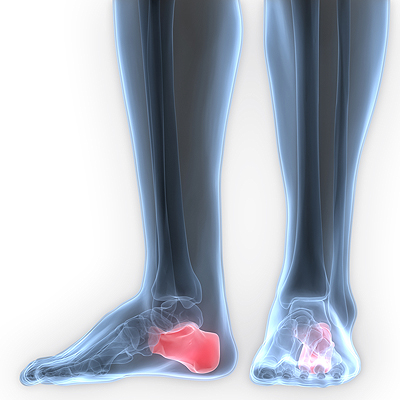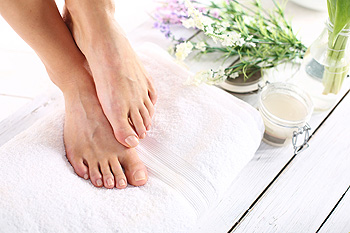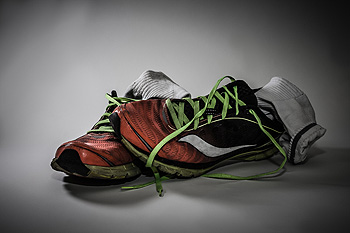Items filtered by date: March 2020
Have I Developed Cuboid Syndrome?
 There is a small bone that can be found on the outside, near the middle of the foot. This is referred to as the cuboid bone, which is attached to the heel bone by ligaments. If the tissues surrounding the cuboid bone become injured, the medical condition that is known as cuboid syndrome may develop. A common symptom that is generally associated with this condition may consist of pain and discomfort on the outside of the foot, which may then spread to the toes. The affected area may become swollen, and make it difficult to walk on uneven surfaces. Additionally, limping may become a natural method of dispersing some of the body’s weight. This condition may be caused by enduring an ankle injury, or if the patient has flat feet. Moderate relief may be found if the affected foot is elevated, as this may help to reduce a portion of the swelling. If you have these types of symptoms, it is strongly suggested that you consult with a podiatrist who can properly treat this condition.
There is a small bone that can be found on the outside, near the middle of the foot. This is referred to as the cuboid bone, which is attached to the heel bone by ligaments. If the tissues surrounding the cuboid bone become injured, the medical condition that is known as cuboid syndrome may develop. A common symptom that is generally associated with this condition may consist of pain and discomfort on the outside of the foot, which may then spread to the toes. The affected area may become swollen, and make it difficult to walk on uneven surfaces. Additionally, limping may become a natural method of dispersing some of the body’s weight. This condition may be caused by enduring an ankle injury, or if the patient has flat feet. Moderate relief may be found if the affected foot is elevated, as this may help to reduce a portion of the swelling. If you have these types of symptoms, it is strongly suggested that you consult with a podiatrist who can properly treat this condition.
Cuboid syndrome, also known as cuboid subluxation, occurs when the joints and ligaments near the cuboid bone in the foot become torn. If you have cuboid syndrome, consult with Dr. Douglas Mckay from New Jersey . Our doctor will assess your condition and provide you with quality foot and ankle treatment.
Cuboid syndrome is a common cause of lateral foot pain, which is pain on the outside of the foot. The condition may happen suddenly due to an ankle sprain, or it may develop slowly overtime from repetitive tension through the bone and surrounding structures.
Causes
The most common causes of cuboid syndrome include:
- Injury – The most common cause of this ailment is an ankle sprain.
- Repetitive Strain – Tension placed through the peroneus longus muscle from repetitive activities such as jumping and running may cause excessive traction on the bone causing it to sublux.
- Altered Foot Biomechanics – Most people suffering from cuboid subluxation have flat feet.
Symptoms
A common symptom of cuboid syndrome is pain along the outside of the foot which can be felt in the ankle and toes. This pain may create walking difficulties and may cause those with the condition to walk with a limp.
Diagnosis
Diagnosis of cuboid syndrome is often difficult, and it is often misdiagnosed. X-rays, MRIs and CT scans often fail to properly show the cuboid subluxation. Although there isn’t a specific test used to diagnose cuboid syndrome, your podiatrist will usually check if pain is felt while pressing firmly on the cuboid bone of your foot.
Treatment
Just as the range of causes varies widely, so do treatments. Some more common treatments are ice therapy, rest, exercise, taping, and orthotics.
If you have any questions, please feel free to contact one of our offices located in Caldwell, and Galloway, NJ . We offer the newest diagnostic and treatment technologies for all your foot care needs.
Ways to Help Treat the Corns on Your Feet
 If you notice a hardened area of skin on the bottom or side of your foot, you may have developed a foot condition that is known as a corn. Corns, often confused with calluses, are rounder and incredibly sensitive to the touch when pressure is applied. Corns may develop due to an intense amount of friction between the skin on your feet and tightly worn shoes, for example high heels. Some patients have found mild relief from the discomfort by using apple cider vinegar and castor oil, vitamin E, lemon peels, and Epsom salts. If you would like to safely remove your corn, and get advice on how to best treat this condition, it is suggested that you seek the counsel of a podiatrist.
If you notice a hardened area of skin on the bottom or side of your foot, you may have developed a foot condition that is known as a corn. Corns, often confused with calluses, are rounder and incredibly sensitive to the touch when pressure is applied. Corns may develop due to an intense amount of friction between the skin on your feet and tightly worn shoes, for example high heels. Some patients have found mild relief from the discomfort by using apple cider vinegar and castor oil, vitamin E, lemon peels, and Epsom salts. If you would like to safely remove your corn, and get advice on how to best treat this condition, it is suggested that you seek the counsel of a podiatrist.
If you have any concerns about your feet, contact Dr. Douglas Mckay from New Jersey . Our doctor can provide the care you need to keep you pain-free and on your feet.
Biomechanics in Podiatry
Podiatric biomechanics is a particular sector of specialty podiatry with licensed practitioners who are trained to diagnose and treat conditions affecting the foot, ankle and lower leg. Biomechanics deals with the forces that act against the body, causing an interference with the biological structures. It focuses on the movement of the ankle, the foot and the forces that interact with them.
A History of Biomechanics
- Biomechanics dates back to the BC era in Egypt where evidence of professional foot care has been recorded.
- In 1974, biomechanics gained a higher profile from the studies of Merton Root, who claimed that by changing or controlling the forces between the ankle and the foot, corrections or conditions could be implemented to gain strength and coordination in the area.
Modern technological improvements are based on past theories and therapeutic processes that provide a better understanding of podiatric concepts for biomechanics. Computers can provide accurate information about the forces and patterns of the feet and lower legs.
Understanding biomechanics of the feet can help improve and eliminate pain, stopping further stress to the foot.
If you have any questions please feel free to contact one of our offices located in Caldwell, and Galloway, NJ . We offer the newest diagnostic and treatment technologies for all your foot and ankle needs.
Types of Corns
 A corn will typically develop as a result of excessive pressure. They can emerge between the toes, or on the bottom of the feet. Corns are described as a small area of skin that has become hardened, and can often be painful and uncomfortable. This ailment may be caused by wearing shoes that do not fit correctly, or from medical conditions that can include hammertoes or bunions. Hard corns typically develop on the top of the outer three toes, and soft corns will form between the toes. Walking may also become difficult when a corn has formed. Some patients have found relief by wearing small pads over their corns, which may help to ease the friction. In addition, covering the corn and wearing shoes that leave ample room for the toes to move freely in, can also be helpful in alleviating some of the pain. If you are afflicted with a corn, it is strongly suggested that you consult with a podiatrist who can recommend proper corn removal options for you.
A corn will typically develop as a result of excessive pressure. They can emerge between the toes, or on the bottom of the feet. Corns are described as a small area of skin that has become hardened, and can often be painful and uncomfortable. This ailment may be caused by wearing shoes that do not fit correctly, or from medical conditions that can include hammertoes or bunions. Hard corns typically develop on the top of the outer three toes, and soft corns will form between the toes. Walking may also become difficult when a corn has formed. Some patients have found relief by wearing small pads over their corns, which may help to ease the friction. In addition, covering the corn and wearing shoes that leave ample room for the toes to move freely in, can also be helpful in alleviating some of the pain. If you are afflicted with a corn, it is strongly suggested that you consult with a podiatrist who can recommend proper corn removal options for you.
If you have any concerns regarding your feet and ankles, contact Dr. Douglas Mckay of New Jersey . Our doctor will treat your foot and ankle needs.
Corns: What Are They? and How Do You Get Rid of Them?
Corns can be described as areas of the skin that have thickened to the point of becoming painful or irritating. They are often layers and layers of the skin that have become dry and rough, and are normally smaller than calluses.
Ways to Prevent Corns
There are many ways to get rid of painful corns such as wearing:
- Well-fitting socks
- Comfortable shoes that are not tight around your foot
- Shoes that offer support
Treating Corns
Treatment of corns involves removing the dead skin that has built up in the specific area of the foot. Consult with Our doctor to determine the best treatment option for your case of corns.
If you have any questions please feel free to contact one of our offices located in Caldwell, and Galloway, NJ . We offer the newest diagnostic and treatment technologies for all your foot and ankle needs.
Soaking Your Feet May Help to Alleviate Discomfort
 Our feet provide support for the overall body. When the feet are properly taken care of, daily activities may easily be completed. The feet may feel better when your shoes fit correctly, and your toenails are frequently trimmed. Many patients find it relaxing to wash and dry their feet daily, followed by using a good moisturizer. This may help to maintain soft skin, which may possibly prevent cracked heels. It is suggested to patients who prefer to get pedicures to ensure that the salon is using clean and sterile instruments. If you would like additional information about the importance of everyday foot care, please consult with a podiatrist.
Our feet provide support for the overall body. When the feet are properly taken care of, daily activities may easily be completed. The feet may feel better when your shoes fit correctly, and your toenails are frequently trimmed. Many patients find it relaxing to wash and dry their feet daily, followed by using a good moisturizer. This may help to maintain soft skin, which may possibly prevent cracked heels. It is suggested to patients who prefer to get pedicures to ensure that the salon is using clean and sterile instruments. If you would like additional information about the importance of everyday foot care, please consult with a podiatrist.
Everyday foot care is very important to prevent infection and other foot ailments. If you need your feet checked, contact Dr. Douglas Mckay from New Jersey . Our doctor can provide the care you need to keep you pain-free and on your feet.
Everyday Foot Care
Often, people take care of their bodies, face and hair more so than they do for their feet. But the feet are a very important aspect of our bodies, and one that we should pay more attention to. Without our feet, we would not be able to perform most daily tasks.
It is best to check your feet regularly to make sure there are no new bruises or cuts that you may not have noticed before. For dry feet, moisturizer can easily be a remedy and can be applied as often as necessary to the affected areas. Wearing shoes that fit well can also help you maintain good foot health, as well as making it easier to walk and do daily activities without the stress or pain of ill-fitting shoes, high heels, or even flip flops. Wearing clean socks with closed shoes is important to ensure that sweat and bacteria do not accumulate within the shoe. Clean socks help to prevent Athlete’s foot, fungi problems, bad odors, and can absorb sweat.
If you have any questions please feel free to contact one of our offices located in Caldwell, and Galloway, NJ . We offer the newest diagnostic and treatment technologies for all your foot and ankle needs.
Excessively Sweaty Feet
 An uncomfortable ailment that causes the feet to sweat excessively is referred to as plantar hyperhidrosis. This condition may lead to foot odor, as well as medical conditions that can include toenail fungus or athlete’s foot. Hyperhidrosis occurs as a result of sweat glands that produce large quantities of sweat, which in turn, may cause embarrassment among affected patients. Research has indicated there may be methods that can be implemented which can help to manage this condition. These can include wearing the right socks for the corresponding season, choosing shoes that are made out of breathable materials, and applying an antifungal powder on a regular basis. Additionally, it may be beneficial to drink plenty of water, as this may help to maintain the normal body temperature. If you are afflicted with plantar hyperhidrosis, it is advised that you are under the care of a podiatrist for professional care and treatment.
An uncomfortable ailment that causes the feet to sweat excessively is referred to as plantar hyperhidrosis. This condition may lead to foot odor, as well as medical conditions that can include toenail fungus or athlete’s foot. Hyperhidrosis occurs as a result of sweat glands that produce large quantities of sweat, which in turn, may cause embarrassment among affected patients. Research has indicated there may be methods that can be implemented which can help to manage this condition. These can include wearing the right socks for the corresponding season, choosing shoes that are made out of breathable materials, and applying an antifungal powder on a regular basis. Additionally, it may be beneficial to drink plenty of water, as this may help to maintain the normal body temperature. If you are afflicted with plantar hyperhidrosis, it is advised that you are under the care of a podiatrist for professional care and treatment.
If you are suffering from hyperhidrosis contact Dr. Douglas Mckay of New Jersey . Our doctor can provide the care you need to attend to all of your foot and ankle needs.
Hyperhidrosis of the Feet
Hyperhidrosis is a rare disorder that can cause people to have excessive sweating of their feet. This can usually occur all on its own without rigorous activity involved. People who suffer from hyperhidrosis may also experience sweaty palms.
Although it is said that sweating is a healthy process meant to cool down the body temperature and to maintain a proper internal temperature, hyperhidrosis may prove to be a huge hindrance on a person’s everyday life.
Plantar hyperhidrosis is considered to be the main form of hyperhidrosis. Secondary hyperhidrosis can refer to sweating that occurs in areas other than the feet or hands and armpits. Often this may be a sign of it being related to another medical condition such as menopause, hyperthyroidism and even Parkinson’s disease.
In order to alleviate this condition, it is important to see your doctor so that they may prescribe the necessary medications so that you can begin to live a normal life again. If this is left untreated, it is said that it will persist throughout an individual’s life.
A last resort approach would be surgery, but it is best to speak with your doctor to find out what may be the best treatment for you.
If you have any questions please feel free to contact one of our offices located in Caldwell, and Galloway, NJ . We offer the newest diagnostic and treatment technologies for all your foot and ankle needs.


